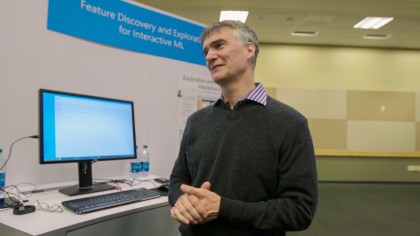Going beyond data scientists: What is machine teaching?
The process of democratising machine learning
The next phase
In a video posted in July, Microsoft Research described its efforts to help people without a machine learning background to teach their systems to learn from experience. "No one has really built a machine learning tool for the layman," said Patrice Simard, Distinguished Engineer and a Deputy Managing Director at Microsoft Research, who is leading a new machine teaching research project. His aim is to make the process of training a machine 'easy, fast and universally accessible'.
"Surprisingly, machine teaching is neglected by ML practitioners both in the academic and the industrial communities," says Simard, who calls machine teaching a 'paradigm shift'.

What is machine teaching?
Machine learning's in-tray is bulging. So good is machine learning, goes the argument, that there are not enough people with machine learning expertise to work on such projects. Machine teaching is a specialised subset of machine learning that attempts to find an optimal training set given a machine learning algorithm and a target model. Say what? "Machine learning is where software algorithms 'learn' to typically 'classify' data in an 'intelligent' form," says Curran.
What is Azure Machine Learning?
Stuffed with tried-and-tested algorithms, Microsoft's Azure ML is designed exclusively for data scientists to use, largely to save time on repetitive tasks. The goal is to produce a machine learning model quickly, and to host it in the cloud for easy accessibility. Niche industry will benefit. For example, with over 400 possible errors, ThyssenKrupp's 1.1 million lifts/elevators are tricky to diagnose and fix, so they feed data into an intelligent information loop created using Azure ML that displays real-time performance on an online dashboard, and tells its technicians how to fix them. At its best, it's predictive, and even pre-emptive.

Machine learning for the masses?
It's time for data scientists and machine learning experts to get out of the way. Microsoft Research wants to widen the field of people who can create, teach and maintain computer models. "Normal non-techies could potentially be 'teaching' machines in the near future, but the reality is more likely that they will be using bespoke highly tailored niche computer applications which are tailored to certain vertical markets that help these people 'teach' machines," says Curran. That still means capturing the as yet untapped 'analogue' expertise of millions of high-levels experts, academics, and others.
How important is Microsoft's involvement?
At present, machine learning is in the hands of Google. That's hardly surprising since language, speech, translation, and visual processing – an evolving search engine's bread and butter – all rely on it. Many of the leading AI and machine learning researchers work for Google. "This effort by Microsoft is to be welcomed," says Curran. "Entry into the field of machine learning is not trivial, and tools to make it easier for non-experts to adopt machine learning should be welcomed – but the research is only in its infancy."
Are you a pro? Subscribe to our newsletter
Sign up to the TechRadar Pro newsletter to get all the top news, opinion, features and guidance your business needs to succeed!
Jamie is a freelance tech, travel and space journalist based in the UK. He’s been writing regularly for Techradar since it was launched in 2008 and also writes regularly for Forbes, The Telegraph, the South China Morning Post, Sky & Telescope and the Sky At Night magazine as well as other Future titles T3, Digital Camera World, All About Space and Space.com. He also edits two of his own websites, TravGear.com and WhenIsTheNextEclipse.com that reflect his obsession with travel gear and solar eclipse travel. He is the author of A Stargazing Program For Beginners (Springer, 2015),
